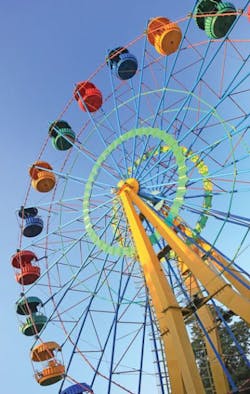Keeping it Safe at Carnivals, Circuses, and Fairs
Most of us have good memories of going to carnivals, circuses, or county fairs as kids. We fondly recall the rides, the clowns, and the ring toss. Those of us who are really lucky can laugh about throwing the baseball that made our math teacher fall into the dunk tank.
The kind of memory nobody wants to take away from one of these venues is the image of someone being carried out on a stretcher — and not moving.
Article 525 exists explicitly for the purpose of protecting carnival goers (and people attending similar venues) from the hazards that arise from the use of electricity at these sites.
Other Articles
With any Chapter 5 Article, you always apply the first four Chapters of the NEC except as modified by the Chapter 5 Article that covers your application. In many cases, additional Code Articles may also apply. For Article 525, those are Articles:
• 518 and 520 for permanent structures.
• 640 for audio equipment.
• 680 for pools, fountains, and other bodies of water.
Conductor clearances
It makes sense that conductor clearances apply. But the clearances for these venues are greater than normal because there’s much more going on than normal. Basically, you have crowds full of kids in relatively huge pedestrian areas.
Normally, you’d use the clearances provided in 225.18 and 225.19. In these venues, the vertical clearances of 225.18 apply. Horizontally, you have a different situation. Instead of a 3-ft [225.19(C)] horizontal clearance, you must establish a 15-ft clearance [525.5(B)] (to portable structures).
Why so much larger? One of the characteristics of these venues is they have a relatively large number of portable structures (e.g., booths, rides, circus tents). In many cases, all of the structures are portable, and the event is in an open lot with no structures of its own.
Remember, this is the clearance to the portable structure. Where the venue has permanent structures, you can use the 225.19 clearances.
These minimums might not be enough for the particular circumstances. Use engineering judgment to increase clearances as needed. For example, if you use the 10-ft clearance of 225.18(1) over a walkway while knowing that a gantry truck is likely to cross that walkway, you’re creating an electrocution hazard.
Protection
Article 110 requires you to provide enclosures or guards to protect electrical equipment wherever it’s likely to be exposed to physical damage [110.27(B)]. This applies to all installations. Oddly enough, the NEC repeats this requirement in several Articles — 525 being one of them [525.6]. Specifically, 525 refers to equipment and wiring methods in (or on) portable structures. But these structures are already covered by 110.27(B).
Power
These installations are typically temporary and outdoor, and typically involve portable equipment. Mix in the crowds that attend these venues, and you have to go beyond Art. 230 requirements for a safe service.
You can’t install service equipment in a location that’s accessible to unqualified people unless it’s lockable [525.10]. While this requirement does appear in other Articles, it doesn’t have a direct counterpart in 110 (General Requirements) or in Art. 230 (Services).
Portable doesn’t mean flimsy. Build or purchase something solid on which to mount the service equipment [525.10(B)]. Unless the service equipment is of weatherproof construction, install it so it’s protected from the elements.
If you have multiple sources of supply, then bond them together [525.11]. This is the only way to prevent dangerous differences in potential. Size the bonding conductor per Table 250.122 based on the largest OCPD supplying the portable structures (but not smaller than 6 AWG). Note that bonding ground rods together requires a specific type of clamp, and the clamp is limited to one conductor per connection point unless listed for multiple conductors.
Cords and cables
Part II, titled “Wiring Methods,” is a bit confusing due to the taxonomy used. The very first subsection is also titled “Wiring Methods,” instead of something unique to that subsection.
A more appropriate title for 525.20 might be “Cords and Cables,” since that’s what it’s all about. Some highlights of this section that are worth noting include:
• All flexible cords or cables must be listed for extra-hard usage [525.20(A)], and they must be continuous (no splices between boxes or fittings) [525.20(D)].
• Single conductor cables must be at least 2 AWG [525.20(B)].
• Keep cord connectors off the ground unless they’re listed for wet locations [525.20(E)].
• Do not use rides or structures to support cords or cables unless they are specifically designed to provide support [525.20(F)].
• Install a box or fitting at each junction point, connection point, switch point, or outlet [525.20(H)].
Wiring rides, tents, and concessions
The ON/OFF switch of a ride isn’t a sufficient means of electrical isolation. You must provide a means to disconnect each portable structure from all ungrounded conductors [525.21(A)]. Install the disconnect such that it is:
• Readily accessible to the operator.
• Within 6 ft of the operator’s station.
• In line of sight from the operator’s station.
• Lockable if accessible to unqualified persons.
If you provide lighting to tents, make sure the wiring is securely installed [525.21(B)]. The NEC does not define “securely” here, so what does this mean?
From other Articles that apply generally to all installations, we know that we must provide support to boxes, fittings, raceway, etc., at recommended intervals. We also know it’s acceptable to fasten a support to something substantial, such as a framing member, but it’s not acceptable to fasten it to something insubstantial, such as a ceiling tile. Nor can you fasten a support to something like a gas pipe. So use the general rules and good judgment to determine whether you’re meeting this requirement.
Some other requirements of note include:
• If any of your power distribution boxes are outdoors, use only weatherproof ones, and mount them at least 6 in. off the ground [525.22(A)].
• If you distribute power using bus bar, the bus bar must be rated at (or more than) the rating of the OCPD supplying the feeder to the box. Always use bus bar connectors when terminating conductors directly onto bus bars [525.22(B)]
• Every receptacle must have overcurrent protection installed within the box [525.22(C)].
GFCIs
You must provide GFCI protection for:
• All 125V, single-phase, 15A and 20A non-locking receptacles if readily accessible to the public and/or if used for disassembly and reassembly.
• Any equipment that’s readily accessible to the public and supplied by a 125V, single-phase, 15A or 20A branch circuit.
The GFCI can be an integral part of the attachment plug, or, if it’s within 12 in. of the plug, it can be in the power-supply cord [525.23(A)].
Sometimes it’s safer not to use a GFCI. For example, you absolutely cannot use a GFCI with egress lighting [525.23(C)]. This rationale is also why you don’t have to use GFCIs for locking-type receptacles that aren’t accessible from grade level and that serve only to allow quick disconnect/reconnect of equipment [525.23(B)]. In this case, you trade the low likelihood of a shock against the higher likelihood of a fall if someone has to climb up to reset the GFCI. To prevent shock, you can open the circuit at the disconnect before climbing up to the receptacle.
Grounding and bonding
Anytime the NEC mentions “grounding,” you should immediately go back to the Art. 100 definition and basic electrical theory. You don’t prevent shock by “grounding” equipment. It is possible to be electrocuted even if you’ve got one foot on a ground rod; if you draw out the circuit and apply Ohm’s Law, you can readily see this.
So don’t go driving ground rods all over the place. That does nothing to eliminate dangerous differences of potential. What you need to do, instead, is systematically bond all metallic objects together. Remember, electrons are always trying to get back to the source, not back to ground. This is why 525.30 requires you to bond all equipment that’s connected to the same source.
This need for bonding does not eliminate the need for grounding. From your bonding system, you need a connection to ground (at the service or separately derived system). Be sure to use an equipment grounding conductor (EGC) that conforms to 250.118. Install it per Parts VI and VII of Art. 250.
Final note on shock prevention
Always verify the continuity of the EGC each time you connect it to portable equipment [535.32]. It’s not an NEC requirement to conduct AC resistance tests across all of the EGC and bonding jumper connections, but with the right tester, this doesn’t take long — and it adds an extra measure of verified reliability.
Lamendola is an electrical consultant located in Merriam, Kan. He can be reached at [email protected].
About the Author

Mark Lamendola
Mark is an expert in maintenance management, having racked up an impressive track record during his time working in the field. He also has extensive knowledge of, and practical expertise with, the National Electrical Code (NEC). Through his consulting business, he provides articles and training materials on electrical topics, specializing in making difficult subjects easy to understand and focusing on the practical aspects of electrical work.
Prior to starting his own business, Mark served as the Technical Editor on EC&M for six years, worked three years in nuclear maintenance, six years as a contract project engineer/project manager, three years as a systems engineer, and three years in plant maintenance management.
Mark earned an AAS degree from Rock Valley College, a BSEET from Columbia Pacific University, and an MBA from Lake Erie College. He’s also completed several related certifications over the years and even was formerly licensed as a Master Electrician. He is a Senior Member of the IEEE and past Chairman of the Kansas City Chapters of both the IEEE and the IEEE Computer Society. Mark also served as the program director for, a board member of, and webmaster of, the Midwest Chapter of the 7x24 Exchange. He has also held memberships with the following organizations: NETA, NFPA, International Association of Webmasters, and Institute of Certified Professional Managers.


